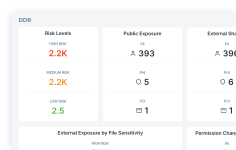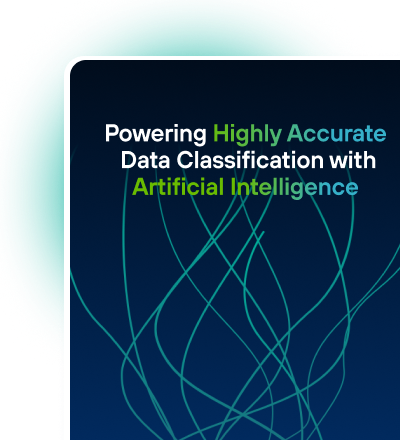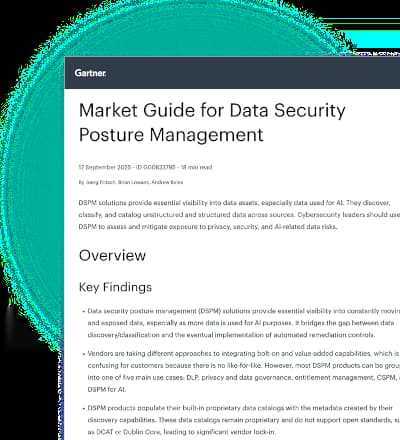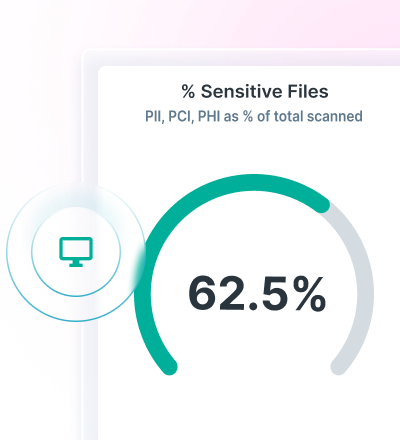Best DSPM Solutions in 2025: Protecting Sensitive Data Across Your Organization
0 min read

Lionel Menchaca
Data is every organization’s greatest asset but also its greatest liability. As cloud adoption accelerates and collaboration tools multiply, sensitive information now lives everywhere, including SaaS apps, data lakes and generative AI tools. The result is a growing visibility gap that many security tools struggle to close.
The Data Security Posture Management (DSPM) market is a direct response to this pervasive challenge. Analysts project a 34% compound annual growth rate (CAGR) through 2034, making it one of the fastest-growing areas in cyber risk management.
According to some estimates, four in five IT decision-makers are already using or planning DSPM implementations, driven by cloud adoption, compliance mandates and the need for continuous visibility into sensitive data.
DSPM software closes the visibility-control gap by continuously discovering where data resides, classifying it by risk, guiding remediation for various threats and enforcing policies that keep it secure. It gives IT and security leaders the insight and control they need to manage data across hybrid and multi-cloud distributed environments.
In this guide, we’ll compare the best DSPM software of 2025 and explain why Forcepoint’s AI-native approach is redefining what effective data posture management looks like.
DSPM Software vs DLP vs CSPM: What’s the Difference?
DSPM doesn’t replace other security controls. It works in tandem with them.
DSPM and DLP are complementary. DSPM focuses on Data Access Governance tasks, securing data at rest by finding and classifying sensitive information, while DLP protects data in motion by preventing unauthorized sharing or exfiltration. Another way to think about it: DSPM keeps the dishes clean; DLP stops them from being taken out of the kitchen.
DSPM and CSPM are also complementary to one another. A robust cloud security strategy often integrates both to protect the underlying cloud environment and the critical data residing within it. DSPM focuses on data, where CSPM focuses on cloud infrastructure details, including cloud service configuration, cloud security policies, etc.
- CSPM (Cloud Security Posture Management) audits infrastructure to prevent cloud misconfigurations.
- DSPM focuses on data-at-rest—discovering where sensitive data resides, classifying it by risk and enforcing least-privilege access and remediation policies.
- DLP (Data Loss Prevention) protects data-in-motion by enforcing policies as information moves through networks, endpoints or cloud apps.
Forcepoint DSPM discovers, classifies, prioritizes, remediates and protects data across its full lifecycle, whether structured or unstructured, in the cloud or on-premises or managed by humans or AI systems.
When combined, DSPM provides deep data discovery and highly accurate classification across multi cloud and storage environment that enables precise policy enforcement through DLP. DSPM provides the visibility and context. DLP turns that insight into real-time adaptive protection across channels.
How DSPM Continuously Improves Data Security Posture
DSPM isn’t a one-time audit; it’s a continuous lifecycle that adapts as data changes.
The strongest platforms follow a five-phase model:
1) Discover: Locate all data across cloud, on-prem, and SaaS environments, including shadow and duplicate copies.
2) Classify: Apply AI-based models to understand sensitivity and business context.
3) Assess: Identify exposures like over-permissive access or data stored in unsanctioned regions.
4) Remediate: Automate corrective actions or open tickets for high-risk findings.
5) Monitor: Continuously rescan to maintain posture as users, data, and environments evolve.
This lifecycle thinking transforms DSPM from a static compliance task into a self-improving process.
The Best DSPM Solutions for Your Business Data in 2025
Below are eight DSPM providers leading the market in 2025. Each brings distinct strengths—but one stands apart in visibility, automation and hybrid coverage.
1. Forcepoint DSPM
Type of solution: Hybrid (cloud + on-premises)
Forcepoint unifies DSPM, DDR and DLP in an AI-native platform that discovers, classifies and protects data across hybrid environments.
Key Features
- AI Mesh-powered classification combining deep neural networks and small language models for unmatched accuracy
- Scans structured and unstructured data across databases, file shares, collaboration platforms, and AI workflows
- Integrated with Forcepoint Data Detection and Response (DDR) to monitor data-in-use and Forcepoint DLP to protect data-in-motion
- Unified dashboard within Data Security Cloud for end-to-end lifecycle visibility
Pros
- Rapid file scanning capability that can classify up to 1 million files per day.
- Manage unified policies across all data states (at-rest, in-use, in-motion)
- Automated remediation for misconfigurations and over-exposed data
Cons
- Best suited to organizations ready for full platform integration rather than standalone deployment
Ideal for enterprises seeking one platform to unify DSPM, DDR, DLP and CASB—especially those operating hybrid or regulated environments.
Here’s what Enda Kyne, Chief Technology & Operations Officer for FBD Insurance, had to say about Forcepoint DSPM and data security:
2. Varonis
Type of solution: Cloud-centric
Now part of the broader Varonis Data Security Platform, Varonis DSPM capabilities focus on entitlement remediation and risk reduction for unstructured and SaaS data.
Key Features
- Data discovery, classification and access analytics across unstructured and SaaS data
- Automated remediation to reduce excessive permissions and exposures
- Real-time policy enforcement and threat detection for sensitive data
Pros
- Deep visibility into unstructured data and entitlements
- Mature reporting and audit tooling for compliance use cases
Cons
- Coverage is strongest for Microsoft and common SaaS data sources
- Narrower multi-cloud DSPM breadth than platforms built primarily for cloud estates
Ideal for organizations that need granular access governance and remediation for unstructured data and Microsoft-first environments.
3. Palo Alto Networks DIG
Type of solution: Cloud-native
DIG DSPM capabilities are now fully embedded within Palo Alto’s CNAPP, offering unified visibility from code to data.
Key Features
- DSPM from the Dig Security acquisition integrated into Prisma Cloud for multi-cloud coverage
- API-based discovery and classification of data stores with risk context from the broader Cloud-Native Application Protection Platform (CNAPP)
- Centralized dashboards for data posture, findings and remediation workflows
Pros
- Tight integration with Prisma Cloud for code-to-cloud context and unified risk views
- Strong fit for organizations standardizing on Palo Alto Networks cloud security
Cons
- Focused on public cloud data stores rather than on-premises systems
- Best value realized when adopted with Prisma Cloud modules
Ideal for enterprises running multi-cloud workloads that already use or plan to adopt Prisma Cloud.
4. BigID
Type of solution: Cloud-first data intelligence platform
BigID excels in data intelligence and privacy governance but relies on integrations for active enforcement.
- Key Features
- Deep discovery and advanced classification for structured and unstructured data
- DSPM with continuous governance and automated remediation
- Integrated privacy capabilities for regulatory mapping and reporting
Pros
- Rich data catalog, compliance mapping and reporting
- Broad environment support with strong multi-cloud coverage
Cons
- Enterprise deployments may require careful tuning to optimize performance and policies
- No real-time enforcement component such as built-in DLP
Ideal for data teams that need DSPM with integrated privacy workflows and broad discovery at scale. Shape
5. Securiti
Type of solution: Cloud + privacy governance
Securiti combines DSPM, privacy intelligence and AI governance in a unified platform that maps and protects sensitive data across hybrid and multi-cloud environments.
Key Features
- Data Command Center unifies data and AI intelligence, controls and orchestration
- DSPM that maps sensitive data, access and risk across hybrid multi-cloud and SaaS
- Privacy and consent workflows aligned to governance and compliance operations
Pros
- Strong privacy-first approach with unified platform for security and governance
- Broad hybrid and multi-cloud coverage with contextual data graph
Cons
- Platform depth may require upfront configuration to align stakeholders and workflows
- Some customers report issues with accuracy or precision of classification
Ideal for enterprises seeking a unified data and AI governance platform with embedded DSPM and privacy operations.
6. Concentric AI
Type of solution: ML-driven data security
Concentric’s AI-driven DSPM doubles as an insider risk solution, using contextual language models to detect exposure and anomalous sharing.
Key Features
- Deep learning and natural language processing for content-aware discovery of sensitive data
- Risk analytics for permissions, sharing and overexposure across cloud and collaboration tools
- Policy recommendations and data detection and response for insider risk
Pros
- Content-centric accuracy for unstructured data with lightweight deployment
- Fast time to value for SaaS and collaboration datasets
Cons
- Fewer native integrations and platform tie-ins than large enterprise suites
- A relatively unproven player in the DSPM field
Ideal for organizations prioritizing precise discovery and risk reduction for unstructured and collaborative data.
7. Cyera
Type of solution: AI-native DSPM platform
Recent updates extend Cyera’s DSPM to monitor AI model training data and data lineage across cloud stores.
Key Features
- Agentless deployment across IaaS, SaaS and on-prem environments
- AI-powered classification engine designed for rapid time-to-value and high precision
- Discovery and classification for both structured and unstructured data
Pros
- Fast time-to-value with agentless deployment
- Strong classification accuracy and intuitive interface
Cons
- Limited remediation automation
- Weaker coverage for complex hybrid environments
Ideal for organizations seeking fast-deploying, cloud-centric DSPM with strong discovery and classification capabilities.
8. Microsoft Purview
Type of solution: Enterprise governance platform
Microsoft has expanded Purview’s DSPM preview to include AWS and Google Cloud connectors, signaling its cross-cloud ambitions.
Key Features
- Discovery, classification and labeling integrated with Microsoft 365 and Azure
- Microsoft Purview Data Security Posture Management for cross-cloud monitoring and risk insights
- Compliance and information protection controls unified with data catalog and governance
Pros
- Deep integration with Microsoft identity, productivity and security stacks
- Single administrative plane for governance, security and compliance in Microsoft estates
Cons
- Cross-cloud capabilities exist but visibility and automation are strongest in Microsoft ecosystems
Ideal for enterprises standardized on Microsoft services that want native governance and evolving DSPM capabilities.
See the complete DSPM Feature Chart for more information.


How to Choose a DSPM Solution Aligned with Your IT Needs
Selecting the right DSPM software requires more than feature comparisons. CIOs should evaluate how well each platform integrates with existing architecture and aligns with long-term strategy.
- 1: Map Integrations with Your Current Tech Ecosystem
Your DSPM must connect seamlessly with identity, ticketing, and security-operations platforms to avoid blind spots.
- 2: Prioritize Compliance and Risk Scoring
Look for solutions that tie data classifications to compliance frameworks and provide quantifiable risk scores.
- 3: Assess Automation and Remediation Workflows
Manual remediation doesn’t scale. Choose vendors offering automated or approval-based workflows.
- 4: Evaluate Hybrid Coverage
If your enterprise uses both on-prem and cloud systems, hybrid DSPM coverage, like Forcepoint’s, is critical.
- 5: Consider AI Readiness
Modern DSPM must secure AI workflows, from model training data to GenAI tools.
The Role of AI-Driven DSPM in Protecting Data in the Age of GenAI
Generative AI continues to shape business productivity and data risk. As employees feed sensitive content into AI tools, confidential information can leak into public or third-party models. DSPM now plays a critical role in mitigating that exposure.
Forcepoint DSPM is powered by AI Mesh technology to bring automation, precision and adaptability to the classification process.
- Contextual Classification: Small Language Models (SLMs) and neural classifiers understand business context, not just keywords.
- AI Workflow Protection: Forcepoint DSPM maps and controls data moving into AI training sets or prompt-based tools.
- Continuous Learning: AI Mesh improves classification accuracy across industries while maintaining data privacy.
DSPM Software FAQs
- How do I choose a DSPM solution for cloud security?
Start by identifying where your sensitive data resides and which environments you need to cover. Choose a DSPM that integrates easily with your existing security tools, supports hybrid cloud environments and offers automated remediation to reduce manual effort. - What is the full form of DSPM?
DSPM stands for Data Security Posture Management. It’s a category of security tools designed to continuously discover, classify and secure sensitive data across cloud and on-prem environments. - What is the difference between DLP and DSPM?
DSPM secures data at rest by finding and classifying sensitive information, while DLP protects data in motion by preventing unauthorized sharing or exfiltration. Used together, they close visibility and protection gaps across the data lifecycle. - What is the difference between CSPM and DSPM?
CSPM protects cloud configurations and infrastructure, while DSPM focuses on the data itself—where it resides, who can access it and how it’s protected. Both work together in a modern cloud security strategy. - Is DSPM part of CNAPP?
Yes. DSPM is increasingly integrated into Cloud-Native Application Protection Platforms (CNAPPs) as the data-layer component that complements workload and infrastructure protection. - Can DSPM help with data compliance?
Absolutely. DSPM maps sensitive data to regulatory frameworks such as GDPR and HIPAA, and provides audit-ready reporting to help prove compliance. - How do I enable DSPM?
Implementation typically begins with connecting DSPM to your cloud storage and collaboration environments. Once connected, it automatically scans, classifies and prioritizes data based on sensitivity and risk. - Who needs a DSPM solution?
Any organization managing regulated, sensitive,or high-value data across multiple cloud or hybrid environments can benefit from DSPM to reduce exposure and maintain compliance. - Which cloud model offers the greatest control over data and security?
Private and hybrid cloud models offer the greatest control, allowing organizations to balance flexibility with strong governance and policy enforcement. - What is the most secure cloud storage in the world?
No single cloud storage provider is the most secure. True data security depends on your ability to discover, classify, and protect data consistently across every environment—a challenge DSPM is designed to solve.
Unify Visibility and Control of Your Sensitive Data
As data grows more distributed and regulations tighten, understanding and controlling your organization’s data posture has never been more critical. DSPM gives CIOs the insight to see where risk hides and the automation to fix it before it turns into a breach.
Among the best DSPM software of 2025, Forcepoint stands apart for delivering an AI-native, hybrid platform that connects DSPM, DDR and DLP into a continuous lifecycle of protection.
Start with a free Data Risk Assessment to see where your most sensitive data lives—and how Forcepoint can help you secure it everywhere it flows.

Lionel Menchaca
Read more articles by Lionel MenchacaAs the Content Marketing and Technical Writing Specialist, Lionel leads Forcepoint's blogging efforts. He's responsible for the company's global editorial strategy and is part of a core team responsible for content strategy and execution on behalf of the company.
Before Forcepoint, Lionel founded and ran Dell's blogging and social media efforts for seven years. He has a degree from the University of Texas at Austin in Archaeological Studies.
 Gartner®: Market Guide for Data Security Posture ManagementView the Report
Gartner®: Market Guide for Data Security Posture ManagementView the Report
X-Labs
Get insight, analysis & news straight to your inbox

To the Point
Cybersecurity
A Podcast covering latest trends and topics in the world of cybersecurity
Listen Now









